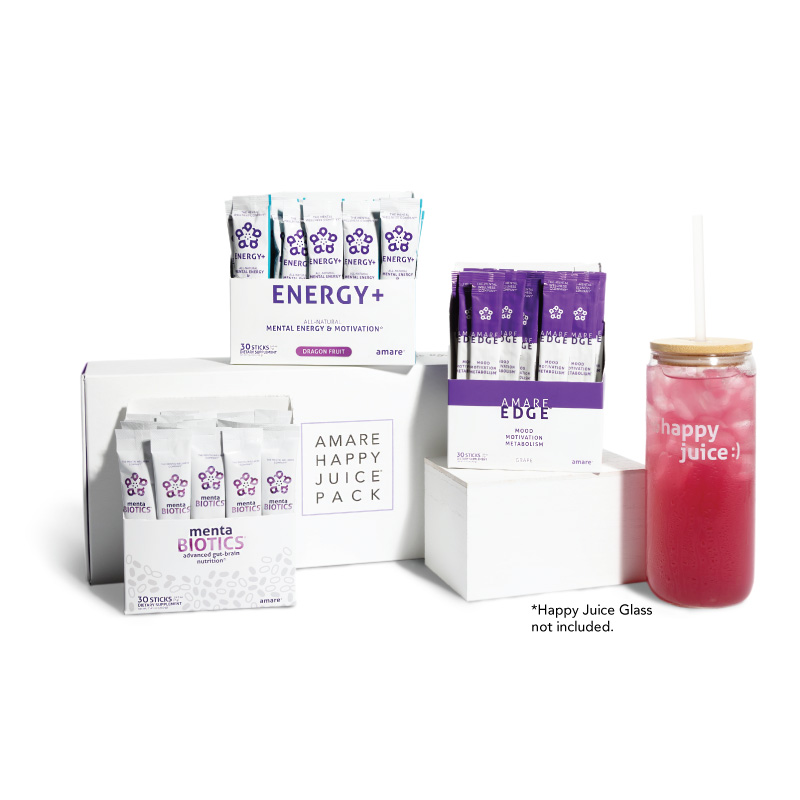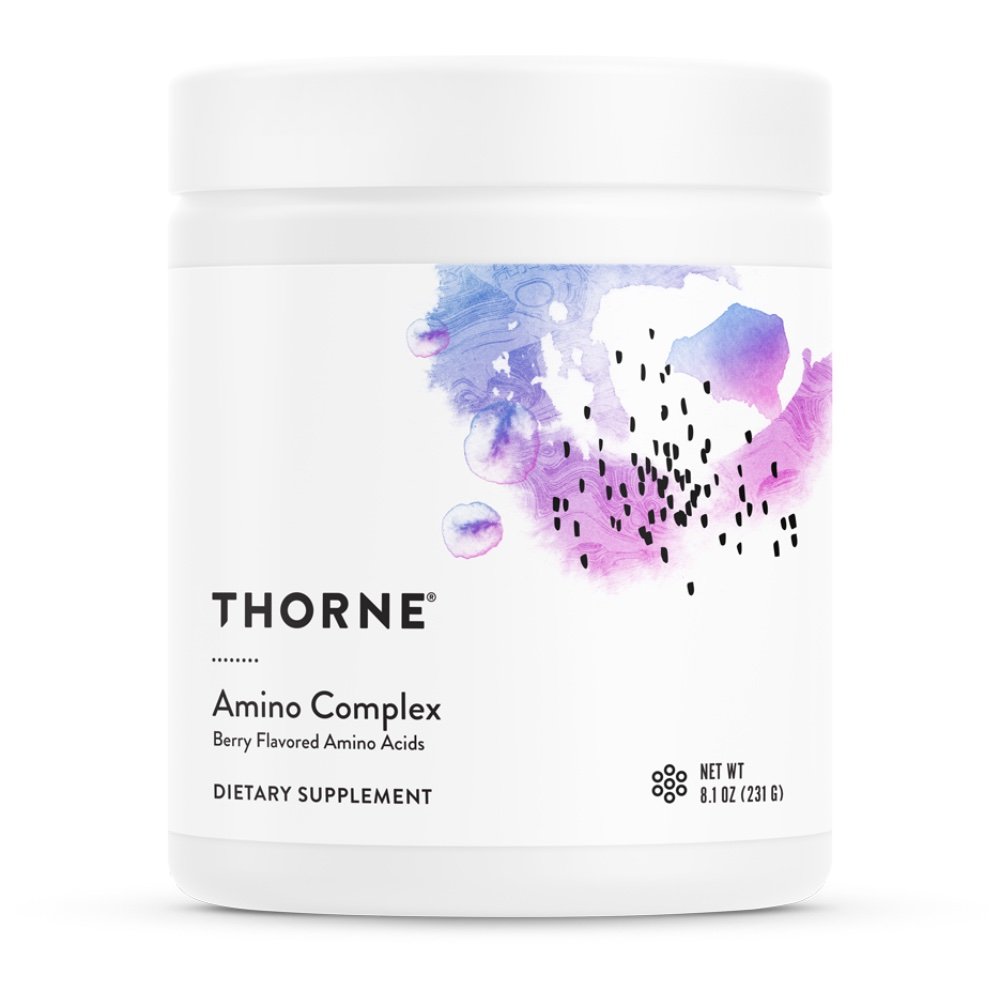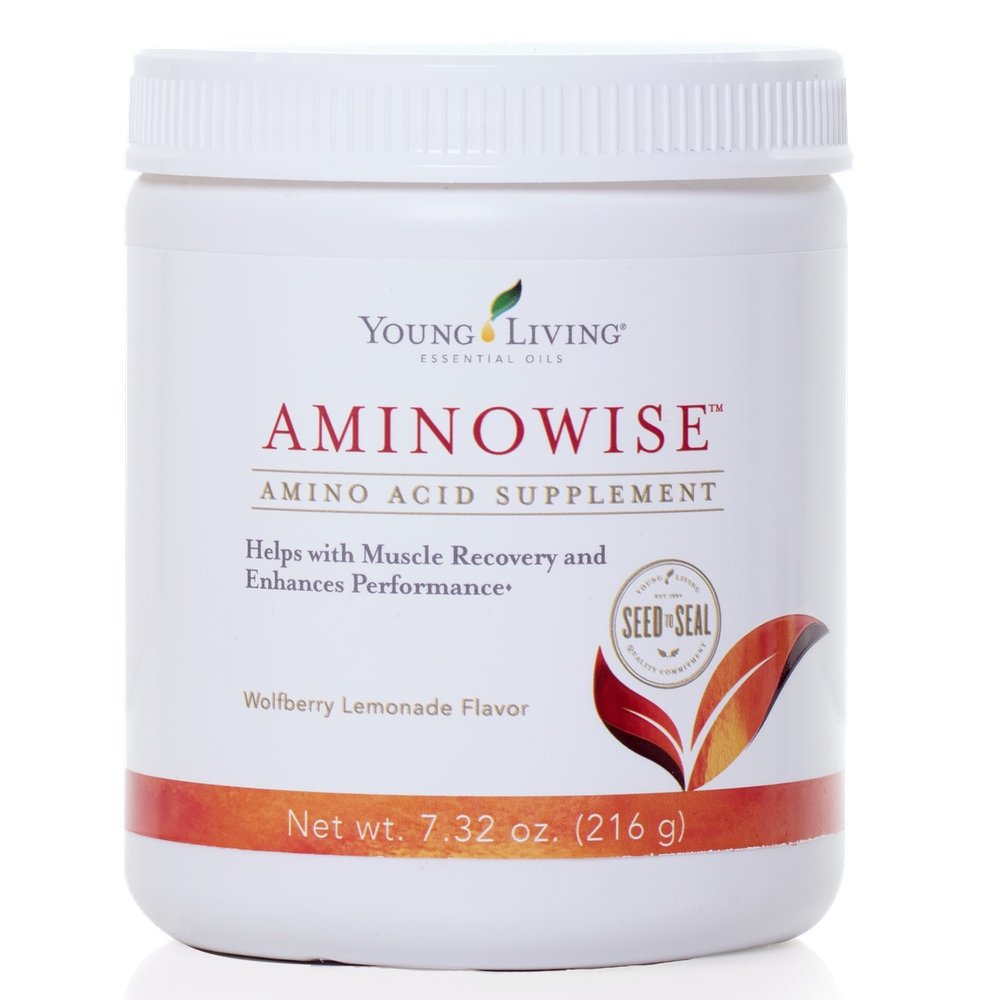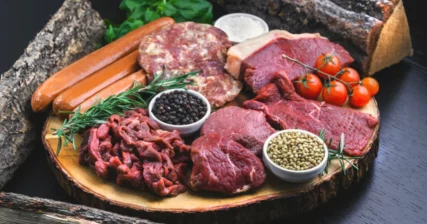Listen on: Apple Podcasts | Spotify
What are amino acids? How do they work? Why are they so important to your health and fitness? Why are they so important as you age?
Your body consists of about 60% water. If you remove the water, about half of what remains would be made of protein. Amino acids are the building blocks of protein.
Every day, about 250-300 grams of the protein that builds your body breaks down. That’s the amount of protein you’d get from six chicken breasts!
When you get sick or injured, you break down even more.
Amino acids (AAs) are made of nitrogen, hydrogen, carbon, and oxygen.

Feel Better Fast. Guaranteed.
Energy+, EDGE, and MentaBiotics make up the Happy Juice supplement stack, with ingredients clinically proven to:
- decrease anxiousness scores by 55%
- decrease irritability scores by 60%
- decrease fatigue by 64%
- decrease anger 54%
- decrease tension by 45%
- decrease confusion by 43%
- decrease overall distress by 49%
- increase good bacteria by 70%
- decrease negative mood by 105%
- increase positive mood by 211%
Types of Amino Acids
Amino acids are either proteinogenic (protein-forming), or non-proteinogenic (non-protein-forming).
Some non-proteinogenic amino acids provide health benefits, but are not required for building tissues in the body. Some of these amino acids include carnitine, ornithine, citrulline, glycine, and beta-alanine. I’ll address some of these in separate articles.
For the sake of this article, I’ll focus on the proteinogenic amino acids. There are 22.
Proteinogenic AAs fall into three different categories:
- Non-essential amino acids are important for your health, but they’re called non-essential because you produce them on your own.
- Conditionally essential amino acids can usually be produced by your body. However, under certain circumstances, your body’s production cannot keep up with its demand, so you must get them through your diet or supplements. Glutamine is a “conditionally essential” amino acid. Under high levels of stress, injury or when someone is severely burned, glutamine stores drop considerably, and and you’d need to eat or supplement glutamine to keep up with your body’s needs. Glutamine is often recommended to support gut health, especially in those who may experience a leaky gut.
- Essential amino acids (EAAs) are “essential” because they cannot be made by the body. You must get them through diet or supplementation.
Of the EAAs, three are superstars. These are the branched-chain amino acids (BCAAs): leucine, isoleucine, and valine. BCAAs make up about 35% of your muscle tissue.
| NON-ESSENTIAL AMINO ACIDS | ESSENTIAL AMINO ACIDS |
| Alanine | Histidine |
| Arginine | Isoleucine** |
| Aspartic Acid | Leucine** |
| Cysteine* | Lysine |
| Glutamic Acid | Methionine |
| Glutamine* | Phenylalanine |
| Glycine* | Threonine |
| Proline* | Tryptophan |
| Serine* | Valine** |
| Tyrosine* | |
| Asparagine* | |
| Selenocysteine | |
| *Conditionally Essential Amino Acid | **Branched-Chain Amino Acid |
Protein Synthesis and Breakdown
Your ability to maintain, or build lean body mass, or muscle, is based on the levels of protein synthesis and protein breakdown throughout the day. As you age, protein breakdown tends to accelerate. Of course, there is much you can do to slow the protein breakdown, including eating more protein and/or supplementing with EAAs.
Lean Body Mass = Protein Synthesis – Protein Breakdown
When protein breakdown exceeds protein synthesis, your body is in a “catabolic” state. Think of someone with anorexia, cancer, or sarcopenia. They quickly lose muscle tissue because breakdown is greater than protein synthesis.
On the other hand, think of an 18-year-old boy going through the later stages of puberty. He goes from being lanky and awkward, to developing biceps and shoulders. In this case, protein synthesis exceeds protein breakdown.
Because your level of muscle mass plays a significant role in longevity, anything that increases protein synthesis or decreases protein breakdown can support your quality of life throughout your lifespan.
Since amino acids play such an essential role in building and maintaining lean body mass, they must be a consistent part of a healthy diet. You can either supplement with them as amino acids, or eat them in protein rich foods like protein shakes, meat, fish, eggs, and poultry.
What should I look for in an amino acid supplement?
First, look for the branched-chain amino acids (leucine, isoleucine, and valine) in a 2:1:1 ratio. This ratio has the most scientific support for the benefit of BCAAs. However, in recent years, more evidence is starting to point at all EAAs as being a necessity when supplementing.
Next, look for a low/no-sugar, naturally-sweetened product. Plain amino acids taste nasty, which is why most companies use artificial sweeteners to mask the taste. Naturally sweetening them costs a lot more, so most companies don’t do that. Better to avoid the artificial sweeteners and find a brand that doesn’t contain them.
Third, look for a product that contains additional, ergogenic amino acids, such as ß-alanine, citrulline, arginine, and glutamine. These may also enhance performance and recovery, as well as further stimulate protein synthesis or decrease protein breakdown.
Added bonus: If you can find a product that also contains electrolytes, unique antioxidants, and/or additional vitamins or minerals, that’s a bonus.
Oh, and be sure you like how it tastes. No matter how good it is FOR you, you won’t use it if it tastes bad. My two top recommended EAA supplements are:
Aging
The same amount of protein has less of an effect on stimulating protein synthesis for older adults than it does for younger adults.
Older adults have to eat more protein to get the same effects as when they were younger. This is called anabolic resistance.
The trouble is, older adults also have less of an appetite, and often, they produce less hydrochloric acid and digestive enzymes. So, even when they eat more protein, they have difficulty breaking it down, unless they supplement with enzymes and HCl.
Supplementing with branched-chain amino acids stimulates protein synthesis and decreases protein breakdown. The AAs are readily absorbed, as they require no digestion, making them very convenient for older adults with less of an appetite and a less effective digestive system.
Loss of lean mass, beginning with middle age, is common, but it doesn’t have to happen at the rate it does for most people. Strength training, plus a higher-protein diet and/or amino acid supplementation can slow the rate of muscle loss.
Aging also causes a change in muscle fiber type, from fast-twitch to slow-twitch fibers. The fast-twitch fibers help maintain normal blood sugar. Amino acid supplementation has been shown to help maintain more fast-twitch, type II muscle fibers.
Muscle Growth and Maintenance
Though amino acids help build muscle, they can also be used by muscle tissue as fuel. As a result, they can help improve physical or exercise performance in athletes, and even in older adults.
Essential amino acid supplementation has been shown to improve the distance older adults could walk before fatigue, or younger athletes could train before wearing out. Branched-chain amino acids may reduce delayed-onset muscle soreness (DOMS), following exercise.
Not only does skeletal muscle use amino acids for energy; the heart can too.
Branched-chain amino acid supplementation has been shown to stimulate “mitochondrial biogenesis,” the creation of new mitochondria. Mitochondria are the “powerhouses of the cells.” Most mitochondria are found in muscle cells, especially type I, slow-twitch muscle fibers. As people age or lose muscle, they also see a loss of mitochondria. BCAAs may slow the loss.
Post-Injury or Bedrest
After an injury, your body needs the right nutrients and amino acids to repair the damaged tissues. That’s pretty obvious.
However, it’s also important that you maintain muscle throughout the rest of your body while your activity and exercise are limited.
In fact, the combination of exercise with any muscle groups that can still be used, plus a higher intake of amino acids can stimulate the right hormones, and provide the right nutrients, to speed up the recovery process.
For example, following my Achilles tendon reattachment surgery on my left leg, I could still train my right leg, and my upper body. Following my bicep tendon rupture and reattachment on my left arm, I could still train the right side of my upper body, and my legs.
This created a better hormonal environment to speed up the recovery process. Meanwhile, I also took a higher-than normal amount of essential amino acids to support the rebuilding of healthy tissues, while at the same time helping to maintain muscle throughout the rest of my body.
Branched-chain amino acid supplementation has also been shown to support normal inflammatory levels, which is important for optimal health and healing.
Weight Management
When you reduce carbs, calories, and your overall food intake to reduce weight, you tell your body, “You’re going to get fewer calories, so you need to get rid of some weight.”
Your body is very smart. It knows that muscle burns more calories than fat. So, if you don’t give your body a reason to keep its muscle, it’ll shed muscle as quickly as it sheds fat.
I can often tell when someone’s followed a low-calorie, lower-protein diet, without any strength training. They become skinny fat. Their body fat levels are still quite high. They just look “skinnier,” but not leaner. They might fit in smaller pants, but they’re not necessarily any healthier.
To maintain muscle, and shed body fat, you must combine strength training with a higher-intake of protein and/or essential amino acids.
Even though your total calorie intake might decrease, protein and amino acid needs increase while on a weight-reduction program.
Personally, I believe that using an EAAs supplement in place of a couple snacks each day is a powerful way to support your metabolism and maintain muscle, while minimizing your total calorie and carbohydrate intake.
Essential amino acids also help maintain normal blood sugar levels, which then helps maintain lower insulin levels. When insulin levels are low, your body can burn more fat for fuel, another important component to reducing body fat.
Supplementing with BCAAs has been shown to stimulate the hormone leptin, which decreases hunger. BCAAs have also been shown improve blood sugar regulation.
You might also find that supplementing with EAAs gives you more energy while dieting. Since they can be used for energy production by the heart and muscles, some people notice an improvement in energy levels, especially if they’re not consuming enough high-quality protein.
Read also: Gym Workout Routines For Beginners and Intermediates
Mood and Emotions
Some amino acids are precursors to serotonin, dopamine, and norepinephrine. Supplementing with BCAAs has been shown to help improve mood and lessen feelings of stress.
In addition, BCAAs have also been shown to support normal brain/cognitive function. They’ve even been studied for their effects on supporting normal recovery from traumatic brain injuries.
Men and women often skip meals, or eat meals with subpar levels of EAAs, leaving their bodies feeling depleted. While amino acids may not increase energy the way a cup of coffee or green tea will, I do believe they can help you maintain a baseline feeling of energy if you’re not getting proper nutrition.
Amino Acid Frequently Asked Questions
I would always recommend eating enough protein over anything else. For optimal health, I believe one gram of protein per pound body weight (or “goal body weight” if you’re on a weight loss diet) is ideal.
Supplementing with essential amino acids can help close a nutrition gap if you’re inconsistent with your protein intake. Even when you do eat enough protein, you can still get an ergogenic effect from supplementing with BCAAs when they are timed appropriately.
Young adults are very sensitive to good nutrition (especially a high-protein diet) and regular strength training. While amino acid supplementation is totally safe, and might provide a small benefit, they may not experience the same results as an older adult might.
The two, best times for most people to supplement with essential amino acids are between meals, and following a workout.
For older adults, supplementing between meals may be especially beneficial, to combat the higher rates of protein breakdown common with aging.
For athletes, supplementing with EAAs before and during exercise improves performance. However, I believe there is an advantage in not using them before and during regular workouts or training, and reserving them for use before and during competition or sport. By training without amino acids (or other nutrients or antioxidants before or during training), you create a greater cortisol and growth hormone response, and produce more free radicals. Although you want to avoid CHRONIC high cortisol and free radical production, short-term exposure is actually good for you. Your body is designed to handle stress and free radical production, and gets better at it, if you expose it to physical stress periodically. Consuming antioxidants and nutrients before and during training blunts this effect.
To maximally stimulate protein synthesis, you only need 8-10 grams of essential amino acids in a meal or snack. You can take the 8-10 grams of amino acids as a supplement, or you could get a 8-10 grams of essential amino acids, by consuming about 20 grams of whey protein, or 25-30 grams of other animal-based protein sources.
That doesn’t mean you only need 25-30 grams of protein, though. While 8-10 grams of essential amino acids maximally stimulates protein synthesis (one part of the equation), you can continue slowing protein breakdown by eating more protein. Research has shown that eating 75 grams of protein in a single sitting slowed protein breakdown more than meals with lesser protein.
The people who benefit the most include middle-aged and older adults, regardless of whether they exercise or not,
athletes and weekend warriors, following training sessions, and before, during and after competition or games, anyone following an injury or illness to support normal inflammatory levels, tissue repair, and immune function, and anyone who won’t have time for a high-protein meal on occasion.
Animal proteins are rich in essential amino acids. Whey protein is considered the best protein because it’s so rich in essential amino acids. If you tolerate whey, use it! If not, you’ll need to pick a different protein source.
Soy protein is also rich in essential amino acids, but soy is surrounded by controversy (especially genetically-modified soy), so you might be better off avoiding it.
If you’re dead-set on avoiding animal protein, you’ll need to use a plant-based protein supplement like pea, rice, and/or hemp protein. It’s very difficult to consume enough amino acids through plant-based foods alone.
Of course, you can easily increase your amino acid intake by using an essential amino acid supplement, too!
Summary
To sum things up:
- Most people don’t eat enough protein or amino acids on a daily basis, to support optimal health.
- EAAs must come from your diet, and animal-based proteins are the richest sources
- BCAAs stimulate protein synthesis, decrease protein breakdown, and may slow the loss of muscle common when dieting, aging, or under chronic stress.
- BCAAs support the building of healthy tissues, may enhance one’s mood, and have been shown to support optimal cognitive function.





